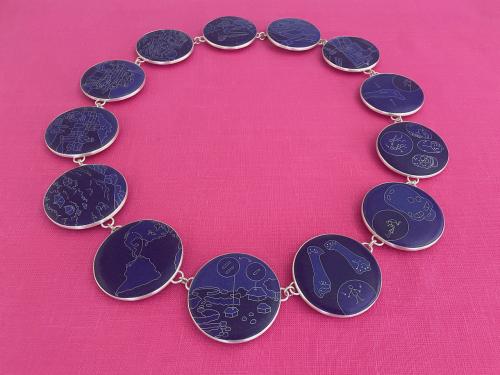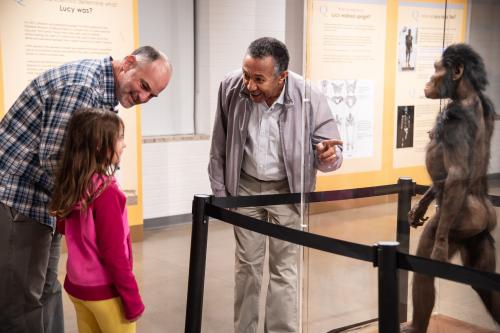
Innovation Gallery
ASU Museum of the Human Story
Innovation Gallery | Free anthropology and archaeology focused exhibits at ASU Tempe
A part of ASU’s Museum of the Human Story, the Innovation Gallery is a free, public museum space located on the ASU Tempe campus inside the School of Human Evolution and Social Change. The gallery showcases rotating, research-driven exhibitions that explore the human story through anthropology, archaeology, culture and science.
Visitors can experience interactive, student- and faculty-designed exhibits, enjoy hands-on learning and see artifacts drawn from ASU’s extensive archaeological, ethnographic, and scientific collections as well as objects from community partners. The gallery also serves as an active laboratory where researchers develop and test new approaches to public engagement and museum design.
Hours & Location
Monday–Friday, 8 a.m.–5 p.m.
Closed on university holidays.
Located in the SHESC building on the ASU Tempe campus
Admission is always free. See below to learn more about our current, and past, exhibits and programs.
Currently on display
Arizona Water Innovation
Nov. 7 - March 25

Humans have innovated to thrive in Arizona for millennia. Today, many access water with the turn of a tap because of the ingenuity of the Indigenous caretakers of the desert lands who built the canals that are the foundation of our present-day water systems. But too many Arizonans still face water insecurity every day.
Arizona Water for All, a part of ASU's Arizona Water Innovation Initiative, invites you to dive into learning about the rich history of our most precious natural resource. The "Arizona Water Innovation" exhibit will take you on a journey through time and invite you to ask yourself: what is the water future I want to create?
This exhibit explores the past, present and the future of water in the Arizona desert through a combination of social science, engineering, history and the arts.
Special event

Evening gallery talk, featuring Associate Professor Joel Palka
"Ancient Maya waterscapes and lessons for Arizona today"
December 10 at 6:00 p.m.
Past exhibits
Message in a Bottle
April 4 - May 8, 2025

Communicating research to the public is an important part of the scientific process. Sharing bioarchaeological discoveries with non-scientists helps the community understand what we do and how we do it, promotes science and STEM education, fosters community engagement, creates advocates for our discipline and conveys information that is often behind academic or publisher paywalls. That said, one of the major challenges of speaking to non-scientist audiences is communicating in a manner that is approachable and free from technical jargon. A way to do this is through artistic representation. The Phoenix Bioscience Core, an Artist + Researcher (ARx) program pairs scientists with professional artists to collaborate on translational pieces of art. Upon completion, the public is invited to view the resulting work, where teams of researchers and artists use the artwork to educate the public about the research and the art.
The Message in a Bottle exhibit showcases the translation of bioarchaeological research in the Peruvian Andes into a suite of cloisonné jewelry that pays homage to Moche metalwork, illustrates the process of conducting excavation and skeletal analysis in the Andes, and communicates paleopathological findings such as traumatic injuries, trepanation, and developmental conditions. This exhibit features artwork by Mary K. Lucking, inspired by the research of Anne R. Titelbaum, a bioarchaeologist and associate professor at the University of Arizona.
Finding Lucy: A celebration of 50 years
Nov. 6, 2024 - Feb. 28, 2025

Fifty years ago — on Nov. 24, 1974 — a young paleoanthropologist named Donald Johanson was walking in the dusty landscape of the Afar Rift Valley of Ethiopia when he discovered the first human ancestor fossil who reliably walked upright on two feet — “Lucy.”
The 3.2-million-year-old fossilized 'Australopithecus afarensis' skeleton remains the most complete representative of human ancestors who were adapting to life on a changing landscape. This discovery is known to be one of the most significant anthropological findings of our time, which ushered in a new era of science-based human origins discoveries.
The Institute of Human Origins and the School of Human Evolution and Social Change have partnered to create an exhibit to mark this milestone in human origins. Through photographs, specimens, casts, and lifelike reproductions, this exhibit tells the story of Lucy's discovery, explores how she fits into the human family tree, and reveals how she continues to inform our understanding of what makes us human.
Hand Made: Continuances in Traditional and Contemporary Art
October - December 2022
The exhibition highlighted continuances in techniques and designs emanating from pre-colonial to contemporary times for Latin American and Latina/o/x artists. Specifically, art making techniques and designs made throughout the various regions of Latin American and the U.S./Arizona.
What is artesania or craft art? It is a system of communal values and aesthetics, that has been passed down through generations of people who possess local or akin knowledge of materials, techniques and customs. The objects created many times embody the everyday lives or experiences of the people who crafted them – as beliefs, dreams, childhood, relationships, livelihood, among others.
During the summer of 2007, the School of Human Evolution and Social Change acquired this collection from the Arizona State University’s Center for Latin American Studies through Jerry Ladman Ph.D. Ladman an economist who directed the center and started this collection in 1976, acquired it from his research-related travels throughout Latin America. While the collection began about 46 years ago, its entrance into SHESC’s collections invited new opportunities for research, education and exhibitions.
3,000 Years of Mexican and Central American Culture: The Deep Roots of Domestic Life in Mesoamerica
February - May 2022
Indigenous cultures in Mexico and Central America have experienced many transformations over time. However, long-lasting cultural continuities can still be seen in native societies in this region called Mesoamerica. These continuities, including maize foods, pottery making, textile weaving, and rituals for healing and community cohesion, remain because of their connections to domestic life. Some of these traditions are even found today in societies in New Mexico and Arizona. This exhibit introduced Mesoamerican cultural features that have continued in some form over 3,000 years or more –the deep cultural roots of household traditions. The clothing, domestic pottery, household utensils, foods, ritual items, and art in this exhibit speak to these continuities. Through the objects and themes on display, we engaged with local communities on interesting and important topics that unite us: households, everyday living, human creativity and cultural identity.
Revealing Artifacts: New Research with the Roosevelt Archaeological Collections at ASU
February - June 2020
Artifacts and records from massive excavation projects around Theodore Roosevelt Lake in central Arizona’s Tonto Basin make up some of the largest archaeological collections at Arizona State University. This material is an invaluable resource for new research. This exhibition features artifacts and images from the Roosevelt collections, specifically highlighting new research with Roosevelt Red Ware pottery as an example of the research potential of the collection.
Metzilocan Extension
March - September 2019
Contemplate the "Monolith of Tlaloc" in the gallery. This display is an extension of the new "Metzilocan" exhibit at the nearby ASU Art Museum, which chronicles artist Claudia Peña Salinas’ research on the Aztec deities of water, relating ancestral symbolism and knowledge to modernist and contemporary structures. The gallery will also feaure items from the school's Latin American collection that were hand-selected by Salinas to accompany her artwork.
Revisiting the Latin American Folk-Art Collection
September 2018 - February 2019
This exhibit is curated by students of the museum studies program at SHESC. It features 104 items from the school’s Latin American folk-art collection of over 400 pieces. Arranged around the themes of daily life, spiritual beliefs, animals and nature, the exhibition speaks to the diversity of Latin American culture. The collection came to the school in 2008 and, a decade later, provides a new opportunity to appreciate these works in the recently renovated Innovation Gallery.